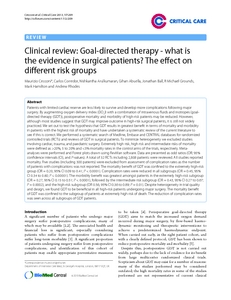Cecconi, M; Corredor, C; Arulkumaran, N; Abuella, G; Ball, J; Grounds, RM; Hamilton, M; Rhodes, A
(2013)
Clinical review: Goal-directed therapy - what is the evidence in surgical patients? The effect on different risk groups.
CRITICAL CARE, 17 (209).
ISSN 1466-609X
https://doi.org/10.1186/cc11823
SGUL Authors: Hamilton, Mark Cecconi, Maurizio Rhodes, Andrew
![[img]](https://openaccess.sgul.ac.uk/107089/1.hassmallThumbnailVersion/cc11823.pdf)  Preview |
|
["document_typename_application/pdf; charset=binary" not defined]
Published Version
Download (561kB)
| Preview
|
Abstract
Patients with limited cardiac reserve are less likely to survive and develop more complications following major
surgery. By augmenting oxygen delivery index (DO2I) with a combination of intravenous fl uids and inotropes (goaldirected therapy (GDT)), postoperative mortality and morbidity of high-risk patients may be reduced. However,
although most studies suggest that GDT may improve outcome in high-risk surgical patients, it is still not widely
practiced. We set out to test the hypothesis that GDT results in greatest benefi t in terms of mortality and morbidity in patients with the highest risk of mortality and have undertaken a systematic review of the current literature to see if this is correct. We performed a systematic search of Medline, Embase and CENTRAL databases for randomized controlled trials (RCTs) and reviews of GDT in surgical patients. To minimize heterogeneity we excluded studies involving cardiac, trauma, and paediatric surgery. Extremely high risk, high risk and intermediate risks of mortality were defi ned as >20%, 5 to 20% and <5% mortality rates in the control arms of the trials, respectively. Metaanalyses were performed and Forest plots drawn using RevMan software. Data are presented as odd ratios (OR; 95%
confi dence intervals (CI), and P-values). A total of 32 RCTs including 2,808 patients were reviewed. All studies reported mortality. Five studies (including 300 patients) were excluded from assessment of complication rates as the number of patients with complications was not reported. The mortality benefi t of GDT was confi ned to the extremely high-risk group (OR = 0.20, 95% CI 0.09 to 0.41; P < 0.0001). Complication rates were reduced in all subgroups (OR = 0.45, 95% CI 0.34 to 0.60; P < 0.00001). The morbidity benefi t was greatest amongst patients in the extremely high-risk subgroup (OR = 0.27, 95% CI 0.15 to 0.51; P < 0.0001), followed by the intermediate risk subgroup (OR = 0.43, 95% CI 0.27 to 0.67; P = 0.0002), and the high-risk subgroup (OR 0.56, 95% CI 0.36 to 0.89; P = 0.01). Despite heterogeneity in trial quality and design, we found GDT to be beneficial in all high-risk patients undergoing major surgery. The mortality benefit
of GDT was confined to the subgroup of patients at extremely high risk of death. The reduction of complication rates was seen across all subgroups of GDT patients.
| Item Type: |
Article
|
| Additional Information: |
© 2013 BioMed Central Ltd, made available here with permission from the publisher. |
| Keywords: |
Science & Technology, Life Sciences & Biomedicine, Critical Care Medicine, General & Internal Medicine, RANDOMIZED CONTROLLED-TRIAL, PULMONARY-ARTERY CATHETERS, CRITICALLY-ILL PATIENTS, MAJOR ABDOMINAL-SURGERY, VENOUS OXYGEN-SATURATION, DELIBERATE PERIOPERATIVE INCREASE, INTRAOPERATIVE FLUID MANAGEMENT, ORIENTED HEMODYNAMIC THERAPY, PERIPHERAL VASCULAR-SURGERY, HOSPITAL STAY, 11 Medical And Health Sciences |
| SGUL Research Institute / Research Centre: |
Academic Structure > Institute of Medical & Biomedical Education (IMBE) > Centre for Clinical Education (INMECE ) |
| Journal or Publication Title: |
CRITICAL CARE |
| ISSN: |
1466-609X |
| Related URLs: |
|
| Dates: |
| Date | Event |
|---|
| 5 March 2013 | Published |
|
| Web of Science ID: |
WOS:000327887300069 |
| URI: |
https://openaccess.sgul.ac.uk/id/eprint/107089 |
| Publisher's version: |
https://doi.org/10.1186/cc11823 |
Statistics
Item downloaded times since 30 Jan 2015.
Actions (login required)
 |
Edit Item |


